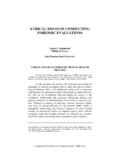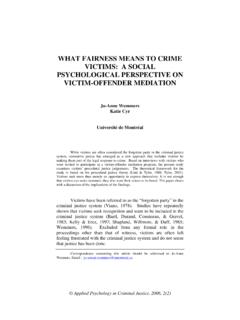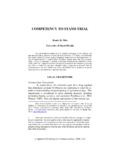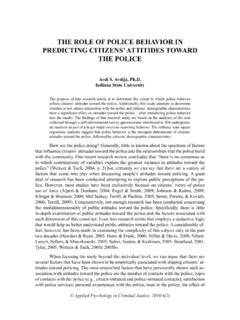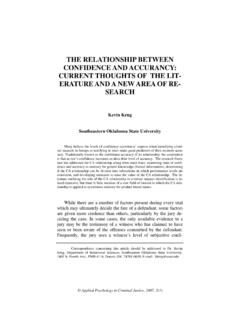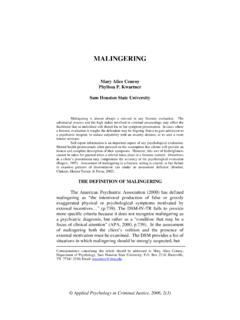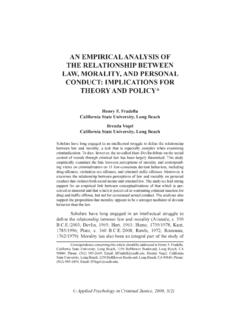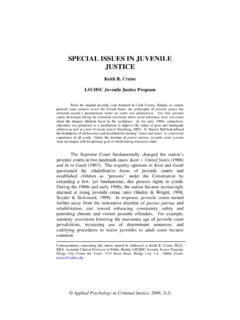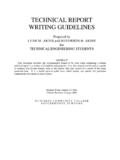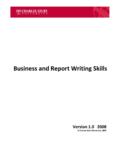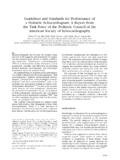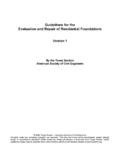Transcription of Report Writing and Testimony - APCJ
1 Report Writing AND Testimony Mary Alice Conroy Sam Houston State University Writing THE FORENSIC Report Numerous psychiatrists and psychologists have contributed to the literature regarding the composition of a good forensic Report (Borum & Grisso, 1996; Heilbrun, 2001; Heilbrun & Collins, 1995; Gutheil, 1998; Nicolson & Norwood, 2000; Rogers & Shuman, 2000; Weiner, 1999). Some texts even include an extensive array of sample reports (Melton, Petrila, Poythress, & Slobogin, 1997; Shapiro, 1999). However, style and format still remain flexible and can be individualized to the author s patterns of analysis.
2 Forensic reports should also be user-friendly and geared to the needs of the targeted audience and the particular questions posed or standards referenced. That said, there are still some general principles of Report Writing that represent the standard in the field, along with specific jurisdictional requirements. Legal Requirements for Criminal Forensic Reports in Texas The best way of determining what is legally required for inclusion in a specific type of Report is to read the statute. Given that statutes are subject to change each time the state legislature convenes, it is important to read the most current version.
3 Instructions relative to commonly requested assessments may be found in the following references: For competence to stand trial reports: Texas Code of Criminal Procedure , Art. 46B Correspondence concerning this article should be addressed to Mary Alice Conroy, , Sam Houston State University, Department of Psychology, Box 2210, Huntsville, TX 77341-2210; Email: Applied Psychology in Criminal Justice, 2006, 2(3) 238 Report Writing For insanity evaluations: Texas Code of Criminal Procedure, Art. 46C For Sentencing determinations: Texas Code of Criminal Procedure, Art.
4 , For competence for execution evaluations: Texas Code of Criminal Procedure, For Sexually Violent Predator assessments: Texas Health & Safety Code, Chapter 841 A review of relevant statutes can also provide the evaluator with the exact standard the trier of fact will be considering: For competence to stand trial: Texas Code of Criminal Procedure, Art. 46B For insanity: Texas Penal Code, Art. 801 For the death penalty: Texas Code of Criminal Procedure, Art. For competence for execution: Texas Code of Criminal Procedure, Art. For Sexually Violent Predator civil commitment: Texas Health & Safety Code, Art.
5 If there are no statutory criteria or standards prescribed, the evaluator s best resources for guidance would be a careful reading of the court order and consultation with the attorney involved. PROFESSIONAL STANDARDS REGARDING WHAT A FORENSIC Report SHOULD INCLUDE Identification of the exact charge and reason for referral This information is often placed at the beginning of a Report . It lets the legal consumer know that the evaluator understands the exact nature of the issues under scrutiny. Confusion may arise when a defendant has multiple charges.
6 Charges may be active in more than one jurisdiction ( , state and federal) or an individual may have a number of charges pending but prosecution is being pursued selectively. It is not uncommon for some charges to be dropped, reduced, or otherwise altered. It Applied Psychology in Criminal Justice, 2006, 2(3) CONROY 239 is, therefore, essential that the forensic evaluator address the specific charge or charges that are currently of concern to the trier of fact. It is equally important that the evaluator be clear as to the psycholegal opinion being sought. For example, if the question is sanity at the time of a particular offense, it should be clear that the evaluator understands the parameters of the issue and is applying the appropriate standard.
7 Documentation of the confidentiality warning Forensic evaluations that are neither court ordered nor mandated by statute will generally require informed consent from the person being evaluated. However, although an evaluation that is court ordered does not require consent, it is nonetheless incumbent upon the evaluator to disclose to the person being assessed the nature of the evaluation, the limits of confidentiality, the procedures that will be involved, the uses to which the evaluation will be put, and who will have access to the results.
8 Even in the case of a grossly incompetent defendant, an evaluator is obligated to make all reasonable efforts to explain the process in terms the individual can comprehend. This process needs to be officially documented in the Report . Sources of collateral information A primary difference between a forensic evaluation and a general clinical Report is the obligation of the forensic evaluator to seek out collateral information. Collateral information reviewed should be specified in the final Report . This would include a list of any documents the professional relies upon in formulating an opinion - mental health records, arrest reports, victim impact statements, criminal history records, etc.
9 It would also include documentation of interviews (in person or by telephone) of collateral sources and the dates these were conducted. In seeking essential collateral information, evaluators are cautioned to be cognizant of the rules of discovery in the case. Some documents may be viewed by evaluators but not shared with one or another of the parties. In such cases the review of the document must still be noted in the Report , but not its contents. Attorneys should be consulted for the specific rules of discovery followed in a particular jurisdiction.
10 Applied Psychology in Criminal Justice, 2006, 2(3) 240 Report Writing Procedures followed This includes a listing of clinical interviews with the defendant, as well as a listing of any psychological tests, actuarial devices, or structured interviews employed. Number and duration of interviews is often of interest to attorneys. If anything unusual transpired, it should also be reported. For example, if the defendant was unable or unwilling to participate in an interview, the evaluator may still be able to reach an opinion or provide useful input, but the limitations of the procedures need to be specified.
